Impact of concentrated flow and shallow water table on pesticides trapping efficiency of vegetative filter strips – A case study of Northeast China
IF 6.1
1区 农林科学
Q1 SOIL SCIENCE
引用次数: 0
Abstract
The Northeast Black Soil Region is a key grain production area in China, facing significant pesticide runoff risks due to extensive agricultural activity. Vegetative filter strips (VFS) are crucial for reducing diffuse pollution, but their effectiveness is compromised by concentrated flow (CF) and shallow water table (SWT) conditions. Quantitatively assessing the negtive effects of these hydrological processes on VFS pesticide removal performance has thus become an urgent issue. This study combined field monitoring with VFSMOD-W simulation to quantify the impacts of CF and SWT on VFS pesticide removal performance. Results show that under typical meteorological conditions in the Black Soil Region, the performance decline of VFS accelerates when CFR exceeds 30 %, and becomes significantly compromised when CFR reaches 60 %. However, SWT effects are less severe, with significant performance declines observed only when it is below 0.5 m. When SWT rises to 0.2 m, outflow reaches 2.2 times the inflow, pesticide removal drops by 55 %, while sediment removal remains stable. When both CF and SWT reach critical thresholds, the decline in pesticide removal is not additive. Pearson correlation analysis and redundancy analysis (RDA) further highlighted that impacting factors explain 86.8 % of VFS performance variability, with CF, SWT, VFS length in the direction of flow (VL), soil vertical saturated hydraulic conductivity (VKS), and rainfall intensity (T) identified as primary influencing factors. To optimize VFS performance, identifying CF pathways and extending VFS length are essential. Additionally, deep plowing to break plow pans and using mixed plant species with robust root systems for riparian restoration are recommended strategies for SWT. This integrated approach offers insights for enhancing VFS efficiency in mitigating agricultural pollution in the Black Soil Region and similar ecosystems globally.
浓流量和浅水位对植被过滤条捕集农药效率的影响——以东北地区为例
东北黑土区是中国重要的粮食产区,由于农业活动的粗放,面临着较大的农药径流风险。植物过滤带(VFS)对于减少弥漫性污染至关重要,但其效果受到集中流(CF)和浅水位(SWT)条件的影响。因此,定量评估这些水文过程对VFS农药去除性能的负面影响已成为一个迫切需要解决的问题。本研究将田间监测与VFSMOD-W模拟相结合,量化CF和SWT对VFS农药去除性能的影响。结果表明:在黑土区典型气象条件下,当CFR超过30 %时,VFS性能下降加速,当CFR达到60 %时,VFS性能下降明显;然而,SWT的影响不那么严重,只有当它低于0.5 m时才会观察到显著的性能下降。当SWT上升到0.2 m时,流出量达到流入量的2.2倍,农药去除率下降55 %,而沉积物去除率保持稳定。当CF和SWT均达到临界阈值时,农药去除率的下降不是添加剂。Pearson相关分析和冗余分析(RDA)进一步强调,影响因素解释了86.8 %的VFS性能变异,其中CF、SWT、VFS流向长度(VL)、土壤垂直饱和导水率(VKS)和降雨强度(T)被确定为主要影响因素。为了优化VFS性能,确定CF路径和延长VFS长度是必不可少的。此外,深耕打破犁盘和使用具有强大根系的混合植物物种进行河岸恢复是SWT的推荐策略。这种综合方法为提高VFS在减轻黑土地区和全球类似生态系统的农业污染方面的效率提供了见解。
本文章由计算机程序翻译,如有差异,请以英文原文为准。
求助全文
约1分钟内获得全文
求助全文
来源期刊

Soil & Tillage Research
农林科学-土壤科学
CiteScore
13.00
自引率
6.20%
发文量
266
审稿时长
5 months
期刊介绍:
Soil & Tillage Research examines the physical, chemical and biological changes in the soil caused by tillage and field traffic. Manuscripts will be considered on aspects of soil science, physics, technology, mechanization and applied engineering for a sustainable balance among productivity, environmental quality and profitability. The following are examples of suitable topics within the scope of the journal of Soil and Tillage Research:
The agricultural and biosystems engineering associated with tillage (including no-tillage, reduced-tillage and direct drilling), irrigation and drainage, crops and crop rotations, fertilization, rehabilitation of mine spoils and processes used to modify soils. Soil change effects on establishment and yield of crops, growth of plants and roots, structure and erosion of soil, cycling of carbon and nutrients, greenhouse gas emissions, leaching, runoff and other processes that affect environmental quality. Characterization or modeling of tillage and field traffic responses, soil, climate, or topographic effects, soil deformation processes, tillage tools, traction devices, energy requirements, economics, surface and subsurface water quality effects, tillage effects on weed, pest and disease control, and their interactions.
 求助内容:
求助内容: 应助结果提醒方式:
应助结果提醒方式:


